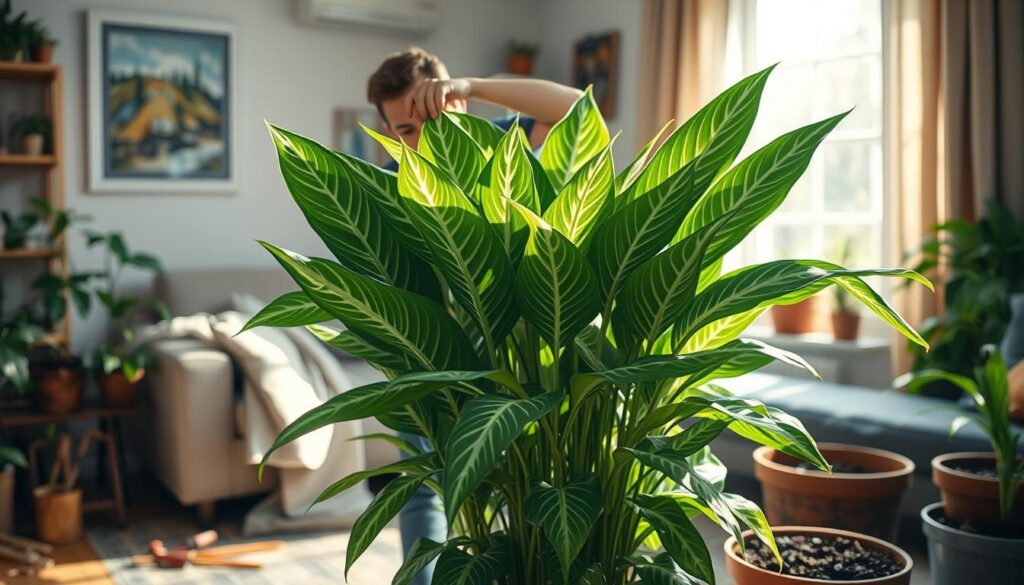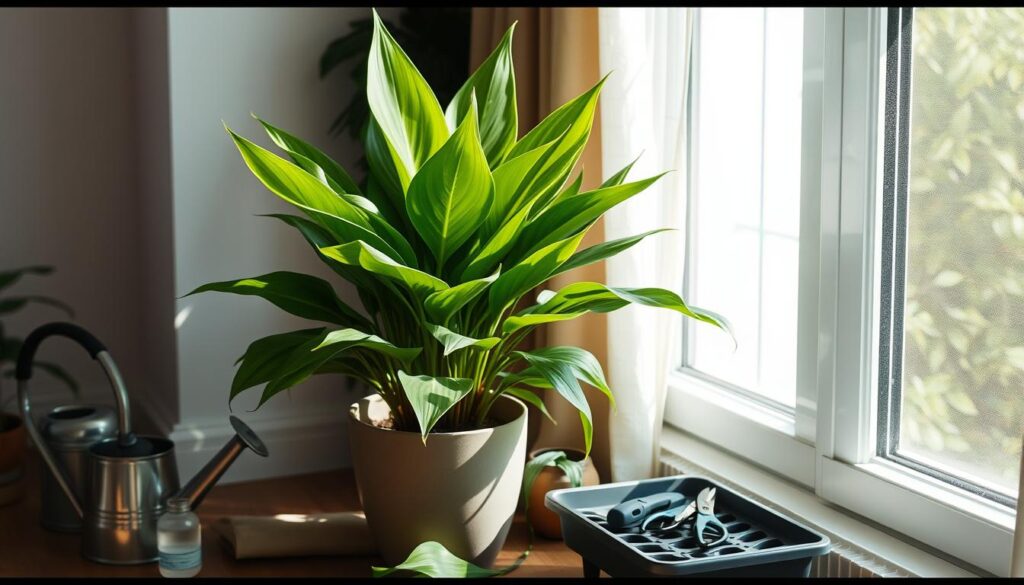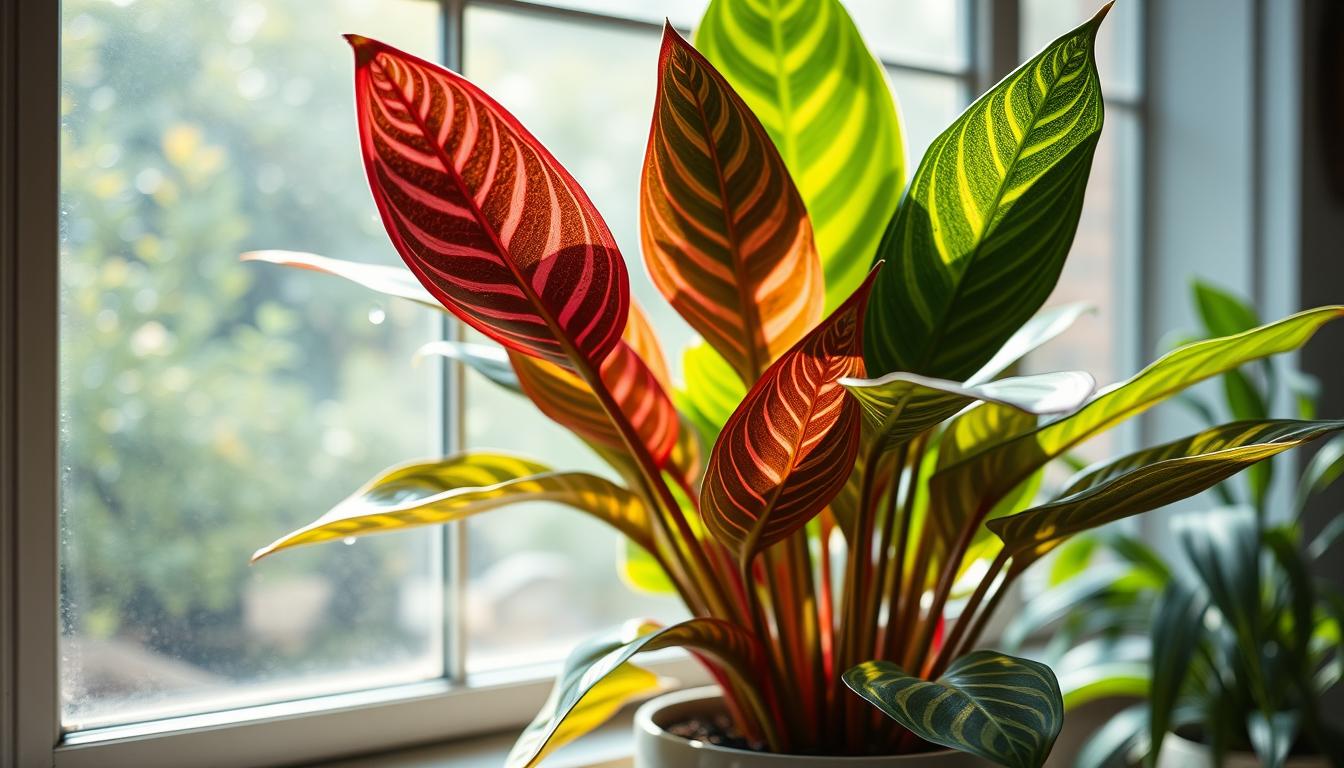Learn how to care for your Dumb Cane plant easily. It’s perfect for beginners. You’ll find caring for it simple with the right tips.
It’s easy to care for your Dumb Cane. You just need to know a few things. Like how much light and water it needs. And when to prune and repot it.
The Dumb Cane is loved for its beautiful leaves. It’s also good at cleaning the air in your home. With the right care, your plant will stay healthy and look great.
Looking for a plant that’s easy to care for? This guide is for you. We’ll teach you about watering, fertilizing, pruning, and repotting. You’ll become a pro at caring for your Dumb Cane.
Introduction to Dumb Cane Care
Starting to care for Dumb Cane plants is exciting. They come from the tropical forests of Central and South America. These plants can grow up to 3-4 feet tall indoors, adding beauty to any room.
Dumb Cane plants like moist soil and moderate watering. They grow best in temperatures between 60°F and 80°F (16-27°C). They can even handle temperatures as low as 50°F (10°C) for a short time. By following these tips, you’ll be a great plant parent.
What Makes Dumb Cane Unique?
Dumb Cane plants have bold, variegated leaves up to 18 inches long. Their unique patterns and colors make them popular houseplants. With over 30 species and more than 100 cultivars, there’s a Dumb Cane for everyone.
The Origins of Dumb Cane
Dumb Cane plants are great for indoor gardens. They do well in low light and are easy to care for. Knowing where they come from helps you care for them better and enjoy their benefits.
A Brief Overview of Its Characteristics
Dumb Cane plants need well-draining soil and fertilization every 4-6 weeks in the growing season. By following these tips, your plant will stay happy and healthy. You’ll enjoy its beautiful leaves for many years.
Choosing the Right Dumb Cane Variety
Choosing the right Dumb Cane variety is key for successful Dumb Cane plant care. There are about 51 types of Dieffenbachia. You can pick the best one for your home from these.
Dieffenbachia seguine, Dieffenbachia ‘Camille’, and Dieffenbachia ‘Compacta’ are popular choices. Each has its own look and size.
Think about what you want. Dieffenbachia ‘Camille’ is good for small spaces because it’s 2-3 feet tall. ‘Tropic Snow’ can grow up to 4 feet tall, making it a big statement in any room. For more tips, check out indoor care tips for palm plants.
Here are some things to think about when picking a Dumb Cane variety:
- Lighting: Some, like Dieffenbachia ‘Compacta’, do well in low light. Others, like ‘Tropic Snow’, need bright light.
- Humidity: Some, like ‘Star Bright’, need a bit more humidity than others.
- Temperature: Most like temperatures between 18 °C and 23 °C.
By thinking about these things and picking the right variety, growing Dumb Cane indoors can be fun. Make sure to learn about your variety’s needs for the best Dumb Cane plant care.
| Variety | Height | Lighting Requirements |
|---|---|---|
| Dieffenbachia ‘Camille’ | 2-3 feet | Medium to bright light |
| ‘Tropic Snow’ | Up to 4 feet | Bright light |
| Dieffenbachia ‘Compacta’ | 1-2 feet | Low to medium light |
Ideal Location for Your Dumb Cane
Choosing the right spot for your Dumb Cane plant is key. It needs the right light, temperature, and humidity to grow well. These conditions help your plant thrive.
Your Dumb Cane likes bright, indirect light. Place it near an east- or north-facing window. It prefers a steady temperature between 65°F to 75°F. Also, it thrives in humid air, best between 60-80%.
Light Requirements: Bright, Indirect Light
For the right light, put your plant by a window with a sheer curtain. This filters the light and meets your plant’s needs.
Understanding Temperature Preferences
Keep your plant away from vents and fireplaces. This helps keep the temperature steady and healthy for your plant.
Humidity Levels for Optimal Growth
Use a humidifier to keep the air right for your plant. This is key in dry winter months. It prevents leaf drop and brown tips. Also, watering Dumb Cane plant and pruning Dumb Cane keep your plant healthy and looking good.
Watering Your Dumb Cane
Learning about watering your Dumb Cane is key. It likes its soil to dry a bit before you water it again. Too much water can hurt the roots, while too little can stress the plant. Watch the soil and water when it’s right.
Repotting your Dumb Cane is important. Do it when it grows twice as big or every year, whichever comes first. This helps the plant grow well by changing the soil and giving it more room.
- Soil dryness: Water when the top soil is dry.
- Light exposure: Brighter spots need more water.
- Temperature: Warmer places need more water too.
Keep these tips in mind to help your Dumb Cane grow strong.
Soil and Fertilization Tips
Right soil and fertilization are key for Dumb Cane plant health. Choose a soil mix that drains well but keeps moisture. Use a mix with peat moss, perlite, and vermiculite.
Selecting the Right Soil Mix
A good soil mix for Dumb Cane plants should have these traits:
- Well-draining to prevent waterlogged soil
- Retains moisture to prevent dryness
- Contains organic matter to promote healthy growth
When and How to Fertilize
Fertilizing is crucial for Dumb Cane plant care. Fertilize every 4-6 weeks in the growing season. Use a balanced, water-soluble fertilizer. A 20-20-20 formula is best for Dumb Cane plants.
Recommended Fertilizers for Dumb Cane
| Fertilizer Type | Formula | Frequency |
|---|---|---|
| Balanced Fertilizer | 20-20-20 | Every 4-6 weeks |
| Seaweed-Based Fertilizer | Varies | Every 4-6 weeks |
Follow these tips for soil and fertilization. Your Dumb Cane plant will get the nutrients it needs. This ensures a healthy, happy plant.
Pruning and Maintenance
Pruning and maintenance are key to keeping your Dumb Cane plant healthy. Pruning helps keep the plant’s shape and promotes growth. It’s a vital part of caring for your Dumb Cane.
When to prune is as important as how. The right tools also make a big difference.
For healthy leaves, remove dead or damaged ones. Cut back overgrown stems. This makes your plant look better and keeps it healthy.

Here are some tips for leaf care:
* Check your plant often for damage or disease.
* Remove dead or damaged leaves to stop disease spread.
* Cut back overgrown stems to keep the plant’s shape and promote growth.
* Use clean, sharp tools to avoid spreading disease.
By following these tips, you can keep your Dumb Cane plant thriving. Enjoy its beautiful foliage for many years.
| Pruning Tool | Description |
|---|---|
| Pruning shears | Used for cutting back overgrown stems and removing dead or damaged leaves |
| Long-handled pruners | Used for reaching high branches and cutting back large stems |
| Gloves | Worn to protect hands from the plant’s irritant sap |
Pest and Disease Management
When you grow Dumb Cane indoors, watch out for pests and diseases. Regular checks and good care can stop problems. Common pests are spider mites and mealybugs.
Look out for yellow leaves, droopy stems, or white cottony spots. Keeping your hands clean and using clean tools helps. This stops pests and diseases.
For pests, try these natural solutions:
- Neem oil: fights spider mites and mealybugs
- Insecticidal soap: controls many pests
- Isopropyl alcohol: cleans tools and stops disease
Follow Dumb Cane care tips and watch for pests and diseases. Regular checks and care keep your plant healthy. This way, your Dumb Cane will grow well.
| Pest/Disease | Symptoms | Treatment |
|---|---|---|
| Spider mites | Yellowing leaves, fine webbing | Neem oil, insecticidal soap |
| Mealybugs | White, cottony patches | Insecticidal soap, isopropyl alcohol |
Propagating Your Dumb Cane
Sharing your Dumb Cane plant with friends or growing more is easy. With proper Dumb Cane care, you can use stem cuttings or division. Pick a healthy stem with lots of nodes for the best chance of success.
Here’s how to propagate your plant:
- Take 2-3 inch stem cuttings with at least one node
- Plant the cuttings in a well-draining potting mix, like sand and peat moss
- Water the soil gently but thoroughly, making sure it feels like a well-wrung sponge
- Place the cuttings in a warm, bright location with indirect light
With Dumb Cane plant care, new leaves and canes will grow in a few weeks. Keep the soil moist but not too wet. Make sure your plant gets enough light and nutrients.
By following these steps and giving your plant the right care, you can grow more Dumb Cane. Enjoy its beautiful leaves for many years.
| Propagation Method | Description |
|---|---|
| Stem Cuttings | Take 2-3 inch stem cuttings with at least one node and plant in a well-draining potting mix |
| Division | Divide the plant into sections, making sure each section has at least one node, and plant in a well-draining potting mix |
Troubleshooting Common Issues
When caring for Dumb Cane plants, it’s key to spot and fix common problems fast. Yellow leaves mean you might be watering too much or not enough light. Change how often you water and make sure your plant gets enough light.
For more info on Dumb Cane plant care, check online. There, you’ll find tips on watering and light. Follow Dumb Cane plant tips to avoid common issues and keep your plant well.
Yellow Leaves: What Do They Mean?
Yellow leaves often mean you’re watering wrong. It could be too little or too much water. Check the soil and adjust your watering.

Leaf Curling: Causes and Solutions
Leaf curling happens from too much fertilizer or low humidity. To fix it, use less fertilizer and make the air around your plant more humid.
By following these tips and watching your plant, it will do great. Always check on your plant and change your care if needed. This way, you’ll avoid problems and keep your plant happy and healthy.
Seasonal Care Tips
When you grow Dumb Cane indoors, you need to change how you care for it with the seasons. In winter, water it less, about once every 10-14 days. This is because it needs less water. To check if the soil is dry, stick your finger into it up to the first knuckle. For more tips on Dumb Cane care, check online.
In spring, water it more often and give it more light. This helps it grow new leaves. Dieffenbachia plants like warm temperatures, between 65°F and 75°F (18°C to 24°C). This makes them perfect for inside your home. Keep it away from cold drafts.
In summer, watch out for too much heat and humidity. Dumb Cane plants like humid air, but they can do well in regular home humidity. To make the air around your plant more humid, put it on a tray with water and pebbles. This keeps the air just right for your plant.
Some important tips for Dumb Cane care through the seasons are:
- Watering: Water less in winter and more in spring and summer
- Lighting: Give it more light in spring and summer, but not direct sunlight
- Temperature: Keep the temperature between 65°F and 75°F (18°C to 24°C)
Benefits of Having a Dumb Cane at Home
Having a Dumb Cane plant at home is great. It purifies the air and looks nice. It also makes you feel better.
It’s easy to take care of a Dumb Cane. With the right steps, your plant will stay healthy and look good.
Some good things about having a Dumb Cane plant include:
- Air-purifying properties: Dumb Cane plants clean the air, making it better to breathe.
- Aesthetic appeal: The big leaves make your home look tropical and pretty.
- Emotional and mental well-being benefits: Studies say plants like Dumb Cane can lower stress and make you happier.
By taking good care of your Dumb Cane, you can enjoy its benefits. It’s easy to care for and adds lots of good things to your home.
| Benefit | Description |
|---|---|
| Air-purifying properties | Removes toxins from the air, improving indoor air quality |
| Aesthetic appeal | Large, broad leaves add a touch of tropical beauty to your home |
| Emotional and mental well-being benefits | Reduces stress levels and improves mood |
Conclusion: Embrace the Beauty of Dumb Cane
Caring for a Dumb Cane plant is very rewarding. With the right care, your plant will grow lush and green. It will also clean the air in your home.
Celebrate Your Success as a Plant Parent
Look at your Dumb Cane and feel proud. You’ve done a great job, whether you’re new or experienced. Your hard work makes your home more beautiful.
Final Thoughts on Caring for Dumb Cane
Keep taking care of your Dumb Cane and enjoy the journey. This plant needs your attention to grow well. With this guide, you’re ready for a great partnership with your Dumb Cane.
For information on other Houseplants that are beginner friendly check out our article on the 12 Best Beginner Friendly Houseplants




